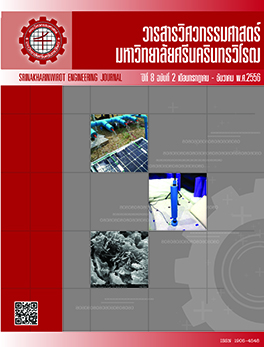การลดเสียงรบกวนแวดล้อมในห้องด้วยวิธีการควบคุมแบบแพสซีพที่แหล่งกำเนิดเสียง
Abstract
ABSTRACT In this work, a continuous and loud ambient noise, emitted from a box of switching hub in a room, was studied. A design for its noise reduction was conducted by applying a method of passive noise control at the noise source. A soundproof box was built to cover and prevent emission noise from the machine and three types of silencers: an acoustical filter, three-duct muffler, and three-duct muffler with fiberglass, were designed and tested for their efficiency for being used in the exhaust system. By applying an assumption that the silencers were linear systems, their frequency responses were measured in an anechoic room. A series of sine sweeps were generated through a loudspeaker and used as the inputs of the silencers and a condenser microphone was used to record the sound emitted from the tested silencers as the system outputs. An analysis was done in frequency domain for comparing relative noise reduction capability of the designed silencers. The result showed that the silencer of three duct muffler with fiberglass was the best in noise reduction and was selected to be used as a proper silencer for the noise control. After installation of soundproof box and the silencer, the averaged level of noise in the room was decreased as much as 10 dBA. The ambient noise level at every location was between 46 - 48 dBA. The result of functional condition test indicated that the functionality and durability of the switching box were not influenced by the noise control method. A questionnaire result also revealed that the applied approach of noise control in the room was most satisfied. Keyword: Room Noise Reduction, Silencer, Frequency Response, Noise Distributionบทคัดย่อ งานวิจัยนี้ศึกษาและออกแบบวิธีการควบคุมเสียงรบกวนในห้องที่เกิดจากตู้แร็คของสวิทซ์ฮับซึ่งกำเนิดเสียงดังต่อเนื่องตลอดเวลา สร้างความรำคาญและเป็นอุปสรรคต่อประสิทธิภาพของผู้ปฏิบัติงานภายในห้อง การควบคุมเสียงรบกวนแบบแพสซีพที่แหล่งกำเนิดเสียงมีจุดประสงค์เพื่อให้ระดับเสียงรบกวนที่ทุกตำแหน่งภายในห้องต่ำกว่า 50 dBA ซึ่งเป็นระดับความดังของเสียงรบกวนที่ยังคงทำให้การสื่อสารด้วยการสนทนาเป็นไปอย่างมีประสิทธิภาพ การควบคุมเสียงรบกวนกระทำโดยสร้างกล่องเก็บเสียงครอบอุปกรณ์และออกแบบท่อลดทอนเสียงรบกวน 3 ลักษณะซึ่งได้แก่ ท่อลดทอนเสียงแบบตัวกรองทางอะคูสติกส์ ท่อลดทอนเสียงชนิด Three-duct muffler และชนิด Three-duct muffler ที่มีไฟเบอร์กลาสบรรจุอยู่ด้านใน โดยได้ทำการทดสอบประสิทธิภาพในการลดทอนเสียงของแต่ละท่อด้วยการใช้สมมุติฐานให้ท่อเป็นระบบเชิงเส้นแล้วเปรียบเทียบการตอบสนองความถี่ของท่อที่วัดได้ในห้องไร้เสียงสะท้อน ใช้การสร้างสัญญาณสวีปไซน์จากคอมพิวเตอร์ผ่านลำโพงเพื่อป้อนเป็นสัญญาณอินพุทให้กับท่อและใช้ไมโครโฟนคอนเดนเซอร์บันทึกสัญญาณและประมวลในโดเมนความถี่ ผลการทดสอบท่อลดทอนเสียงทั้ง 3 แบบ พบว่าท่อลดทอนเสียงชนิด Three duct muffler ที่มีไฟเบอร์กลาสอยู่ภายในมีประสิทธิภาพดีที่สุด ซึ่งเมื่อได้ติดตั้งกล่องเก็บเสียงและท่อลดทอนเสียงรบกวนพบว่าระดับเสียงรบกวนภายในห้องลดลงได้มากถึง 10 dBA โดยทุกตำแหน่งในห้องมีระดับความดันเสียงระหว่าง 46 - 48 dBA และการติดตั้งอุปกรณ์ควบคุมเสียงรบกวนไม่ส่งผลกระทบต่อสภาวะและประสิทธิภาพในการทำงานของสวิทซ์ฮับ นอกจากนี้ผลจากแบบสอบถามพบว่าผู้ทำงานภายในห้องมีความพึงพอใจอย่างมากต่อการควบคุมเสียงรบกวนแวดล้อมที่ได้ดำเนินการ คำสำคัญ: การลดเสียงรบกวนในห้อง ท่อลดทอนเสียง การตอบสนองความถี่ การกระจายตัวของเสียงรบกวนDownloads
Download data is not yet available.
Downloads
Published
2014-02-04
Issue
Section
บทความวิจัย
License
ลิขสิทธิ์เป็นของวารสารวิศวกรรมศาสตร์ มหาวิทยาลัยศรีนครินทรวิโรฒ





